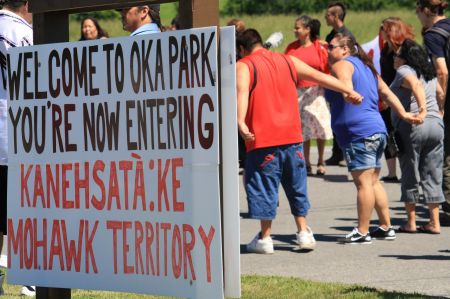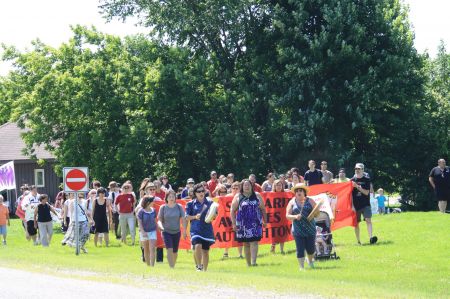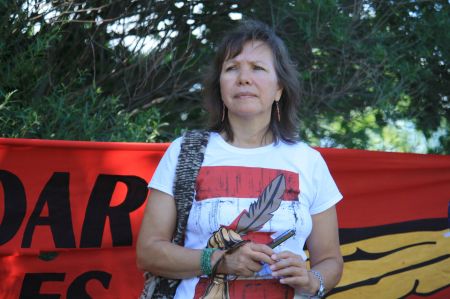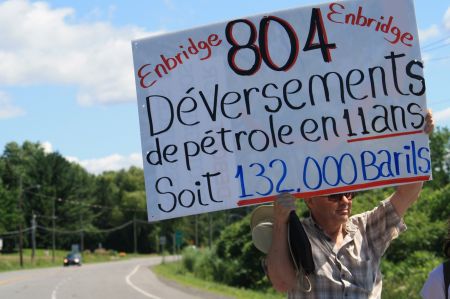KANEHSATÀ:KE MOHAWK TERRITORY--On the 23rd anniversary of what has become known as the 1990 Oka Crisis, a hundred people gathered at Oka Park, on traditional territory of the Kanien'kehà:ka (Mohawk) people of Kanehsatà:ke, to mark what organizers called the start of a new battle against unauthorized development on Mohawk land.
"We have neglected this part of our territory, thinking that what the white man calls a reservation is where we're entitled to live. Today we see the exploitation, appropriation of our lands, by companies like Enbridge, who already have their pipes in the park, by Gazoduc who fracked without our knowledge," said Ellen Gabriel, a member of the Kanien’kehá:ka nation - Turtle Clan and an outspoken voice in favor of Indigenous sovereignty. "And so it's really important that today, this be the beginning of many kinds of demonstrations from our people. Not just Mohawks, but all people. We only have one planet, we must protect Mother Earth. And that is what this is about."
The rally served to send a message to oil company Enbridge about their un-approved excursion into Kanehsatà:ke territory, to inspect their oil pipeline running through the nearby town of Mirabel, Quebec. The inspection, which includes drilling deep into the ground, is part of Enbridge's preparations to reverse the flow of this pipeline, known as Line 9. The change in direction will allow the company to pump oil from west to east, rather than the current east to west, giving them the ability to move oil from Alberta all the way to ports on the East Coast. The reversal is currently being reviewed by National Energy Board (NEB), and is already being met by large amounts of protest and criticism.
The company's application to the NEB asks for approval to ship not only conventional crude oil through the pipes, but heavy oil as well. Many, including oil industry observers, believe the goal is to eventually send tar sands crude through Line 9, since routes west like the Northern Gateway pipeline (from the tar sands to BC's coast) have been delayed due to review, protest and popular pressure.
Critics of the Line 9 reversal are concerned that the pipeline will allow the tar sands to expand even more quickly. They are also opposed to the transport of dirtier tar sands bitumen through their communities, which they say will increase the risk of devastating oil spills. Three years ago, an Enbridge pipeline leaked 832,000 gallons of tar sands bitumen into the Kalamazoo river in Michigan, severely damaging the local ecosystem. That spill is still being cleaned up today.
In June, there was a six day occupation of an Enbridge installation along Line 9 in Hamilton to protest the reversal, and municipalities across eastern Quebec and in the northeastern United States have been speaking out and passing resolutions in hopes of blocking Enbridge's plans.
The fact that Enbridge's exploration came on the anniversary of the Oka Crisis was not lost on those who attended.
"Twenty-three years ago it was about development on our lands. Twenty-three years later, it's the same issue, except now we're aware that Gazoduc is there [doing natural gas exploration], GDB Construction is trying to build more condos on this beautiful field that we see behind us, and Enbridge has their pipelines which they want to use to bring in dirty oil,” said Gabriel. “So you know, we're here as front line protectors for our present and future generations. And we need people to know that the government lied to them. They did not settle the issue as they promised us during negotiations in 1990.”
The 78-day stand-off of the Oka Crisis was sparked by the decision of the municipality of Oka to extend a golf course and build luxury condos on land that was part of the traditional territory of Kanehsatà:ke, including a burial ground. Mohawk warriors established a blockade, and eventually the Canadian military was called in to try and put an end to the conflict. The standoff ended in September 1990, and the federal government purchased the land in question to stop further development. They have, however, refused to transfer the land to the community of Kanehsatà:ke.
Many other groups were present at the demonstration to express their support and to speak out against Enbridge's plans, including Idle No More - Quebec, the Montreal chapter of the Council of Canadians, Greenpeace, the Regroupement de solidarité avec les Autochtones (which was founded during the Oka Crisis) and Climate Justice Montreal.
“Today is a remarkable day. It marks the 23rd anniversary of the so-called Oka Crisis. It's the first day in which Endbridge plans to drill and inspect its pipeline,” said Mike Finck, from Climate Justice Montreal. “For the people here, it represents the struggle behind as well as the struggle ahead. For corporate interests, it represents business as usual. As far as corporate interests go, Enbridge is an ambassador of one of the worst of them, the Alberta tar sands. We stand here in solidarity with Indigenous communities who are most impacted by dirty energy extraction and climate change. Indigenous peoples have been resisting destructive resource extraction for longer than anyone else and when their rights are respected, all of us benefit."
Following the speeches, people at the protest decided to move to the street. Led by a trio of Mohawk women drummers, they walked to highway 344 which runs past the park and started a round dance. Traffic on the busy road was significantly slowed down. As one of the organizers with Idle No More - Quebec said, it sent a strong message: “You can no longer pass us by without recognizing -and respecting- our presence.”
Tim McSorley is an editor with the Media Co-op and a member of the Montreal Media Co-op collective.







